

|
Home Updates Hydros Cars Engines Contacts Links Contact On The Wire |
A 'Better Dooling'?
It is difficult to believe now, but at one stage almost the entire entry list at a European Championship would be made up of just two manufacturers, Oliver and Dooling, Oliver dominating 1.5cc and 2.5cc classes and Dooling the 5cc and 10cc. Domestic events were similarly weighted in favour of the British diesel and the American duo, although a few other makes would be apparent in these home meetings. Whilst there could be a serious waiting list for Oliver engines, with Doolings, it was simply the difficulty in obtaining them with the currency restrictions in place at the time and severe import regulations to overcome. It would not be wrong to say that there was a flourishing black market in Dooling motors and tethered cars from the US in the late 40s and in to the early 1950s. Many came into the UK in the baggage of US servicemen or through their PX yet never made the return journey. Other were smuggled across borders to head to the UK via very circuitous routes, many having seen service in class C speed planes, which accounts for so many of the motors appearing in cars having seriously shaved exhausts. One suspects that of the Doolings that arrived in Britain up until the mid 50s only a minute proportion arrived legally. There were British motors available at about the same cost as the Doolings, but sadly, they were heavier and not as powerful, so if you wanted to win, it had to be a Dooling. Countries where there was no influx of US personnel and with equally restrictive import and currency controls faired even less well.
The combination of needing a Dooling to compete, but not being able to get one legally, or afford one if you could, led to a cottage industry of individuals and even small companies copying the design. Oddly, apart from George Stone's dramatic results in the late 40s with a Dooling, the engine never found favour with tethered hydroplane racers where the McCoy ruled the roost, and yes, was extensively copied as well. It would be impossible to work out just how many, exact, close, near, more or less, and just looks like a Dooling copies have been made, but almost without exception, they share one feature, they were never quite as good as the original.
However, through another of the series of strange circumstances and coincidences that we revel in, we have been able to gather together material about the one 'exception', the AMRO and its successor the FRIRO, yes, same engine, but different names for reasons that will become apparent. The impact of this Swiss venture was down to three factors. Firstly, it was an almost exact copy of the Dooling 61, secondly, it was produced by a precision engineering company and thirdly, developed by competitors operating at the top level of the sport, although that came later.
|
The demand for Dooling 61s in Europe by the mid 1950s was not matched by the availability, especially as the mortality rate on crankcases was so high, which is probably what prompted Otto Amrein to commission a 'Swiss version' late in 1953 or early 54, as well as satisfying the Amrein's own need for a 10cc tethered car engine. Otto, a business man involved in marketing and exporting, could see a ready opportunity to supply much of Europe with a 'Dooling alternative'. The engine was to be built by FRIRO AG a precision engineering and supply company from Wichtrach a few km south of Bern and run by Fritz Rolli.
The new engine, as Jim Dean stated in his review in
February 55, was literally copied from a Dooling in every respect'. He
goes on to comment 'on the exceptional standard of engineering that has
been put into the production of these engines, equal to that of Messrs
Dooling'. It had not been all plain sailing though as serious problems
were encountered with the casting of the crankcases. The difficulty was
in getting the molten aluminium to fill the sharp undercuts beneath the
bottom fin, the top of the bypass and the corners of the exhaust stack,
despite serious pre heating of the dies. Contemporary accounts suggest
that less than 20% of the early castings were useable and even now,
examples can be found with clear flow marks in this area. Unless
pressure or chill die casting is used, this problem still exists to this
day, with porous crankcases and blow holes even evident in an entire batch of
Picco EXR motors. |
|
|
|
Although the machining was of the highest quality, the casting was never as crisp as that of the Dooling, retaining the bright aluminium finish from the dies. Eventually enough crankcases were available to build a batch of 10 prototype engines in 1954, but the troubles were not over as the engines were neither reliable or powerful enough and as yet, did not carry the AMRO name, made up of the Initial letters from AMrein and ROlli. Otto Amrein and his brother Erwin were using the engines, but had neither the experience or a competitive car to move the project along so a decision was made to pass engines to leading competitors to assess, alongside their own development work. Left Otto and Erwin Amrein with their sister and Amro engined cars Landikon 1954 |
Jim Dean was a regular visitor to the Swiss tracks wining the 1953 European Championship at Landikon, where he almost certainly came into contact with Amrein for the first time. Winning again in 1954 with Doolings he was an obvious choice to offer advice on the development of the motor having written two detailed articles on tuning and race preparation of the Dooling motor following his successes. Jim received two of the prototype engines towards the end of 1954, a conventional rotary valve version and one with a 'petal or flutter valve' that several manufacturers and builders were experimenting with at the time.
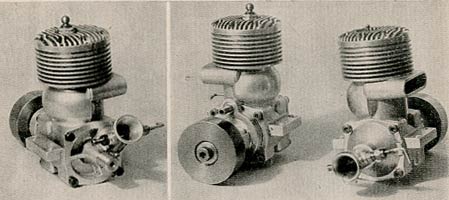 |
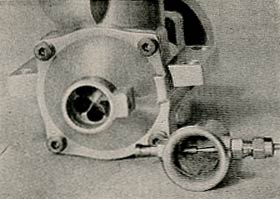 |
| AMROs sent to Jim Dean in 1954 for evaluation, no logo as yet | Inlet for the 'flutter valve' |
In his Model Maker article in February 1955, although full of praise for the quality of engineering, Jim was critical of the piston, which was heavier than that of the Dooling and the liner, possibly the cause of the seizures that were occurring. In its prototype state the conventional motor was rated at 1.5bhp at a modest 16,000rpm somewhat below that of a Dooling. The petal valve model was even less powerful with just over 1bhp at 14.500rpm. Even worse, it had absolutely no grunt at all, with no measurable power until 7,000rpm, plenty of work for the horser there? From the article it would appear that the engines were being run on KLG glow plugs rather than spark ignition and with the contact breakers removed.
|
With modified liners and pistons fitted, power increased significantly with the rotary valve engine now knocking out 1.75 bhp at 18,000rpm and still going, which Dean considered was about the same as his Doolings were producing. The petal valve motor was up to 1.37bhp at 16,000rpm, but with the power dropping off dramatically and still no low down grunt. Compare this with a standard Dooling 61 that was rated at around 1.75bhp on straight fuel and up to almost 2bhp with a serious load of nitro onboard. With a quoted price of 150Chf (about £13 with the generous rate of exchange at the time) the AMRO was about the same price as the British engines or a Dooling, but importantly, available. Right: Last version of the flutter valve engine, an original photo from the Rolli family. Early casting without a logo suggests that this alternative induction system was not pursued any further? |
|
Laidlaw-Dickson's introduction to Jim's article commented "At last enthusiasts have available to them (at the expense perhaps of holiday sheckels) the raw material for some very fast motoring". Jim Dean also suggested that if any traders in Britain were interested in representing the make, then he could put them in touch with Amrein, who given his business, we would imagine was going to be the exporter?
Production of the engines began in 1955 with a relatively small <AMRO> logo cast on to the bypass with 61 below, very much in the style of the Dooling. However, to make inroads in to the market the motor had to be seen to be successful, and here was the problem. Jim Dean was sticking with his Doolings, as were most other British and European competitors, so the anticipated sales were not yet forthcoming. It was not until the 1956 season, when Freddy Streun won the Swiss Championship with one that the possibilities of the motor began to be recognised. The following year, Swiss drivers Kurt Zahnd and Willy Jaberg were also amongst those that adopted the AMRO engine, with Willy recording the motors first international success in winning the European Championship in Dortsfeld, Germany.
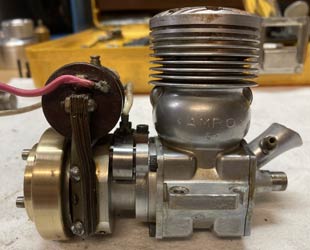 |
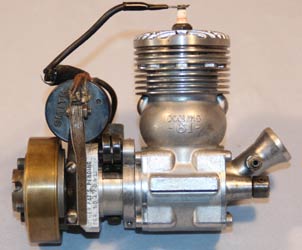 |
| Spot the difference, AMRO left, Dooling, right. Dooling has cast in stubs for head screws, AMRO a solid band | |
This established the credentials of the engine and created a demand throughout Europe, both for use in tethered cars and Class C speed planes. Although Jim Dean was obviously in contact with Amrein and Rolli and involved in the development of the engine, there is no evidence that he ever used one in anger. Correspondence from early in 1957 indicates that he was expecting one of the latest motors to be sent from Switzerland for him to use, but again no evidence that it was ever delivered as Jim soldiered on with his Doolings to the end of his racing. Perhaps this contributed to the realisation that motors that by then were selling for 200Chf could not just be given away?
The Swiss racers mastered the use of the AMRO to such an extent that the first three places at the 1958 European Championships in Zurich were down to Zahnd, Streun and Jaberg with Kurt Zahnd setting a new record at 225kph some 28kph faster than his team mate Jaberg the previous year. A further five of the entries in the 10cc class also used AMRO engines. This success led Ron Moulton to cite it as the motor of choice for tethered cars in his 1958 encyclopaedia, but that also heralded the end of the AMRO. Despite the price having increased to 200Chf, the motor was never going to make money, which resulted in Otto Amrein withdrawing from the venture with around forty AMROs having been built in total, the ten prototype and approximately thirty production versions. Fritz Rolli had realised previously that producing engines was going to be more a philanthropic activity, rather than profitable so began to produce the engines under his company name FRIRO, derived from FRItz ROlli.
The first of the FRIRO motors appeared in 1959 with minor modifications, including the use of a twin plug head. The initial run of the FRIRO motors had the name engraved in very large letters into the bypass, presumably after the original AMRO had been removed? Later engines did have the dies altered to have the logo cast, but still in large letters wrapping round the bypass. The newly named engine carried on from the successes of its predecessor with Freddy Streun winning the European Championship in Turin at 227kph and later setting a new record of 229.592kph. The Swiss trio won a remarkable eight European Championships and two World Championships between them from 1957-1962
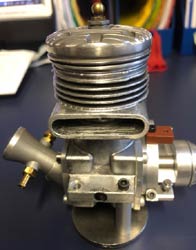 |
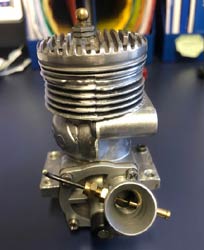 |
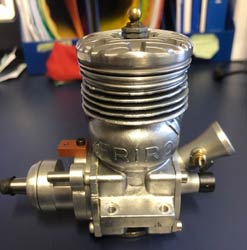 |
| The provenance of this FRIRO confirms its originality. Note the flow marks in the casting | ||
Apart from the small inroads that the Swiss engine made in the 10cc class in its two guises, the entry lists through to the end of the decade were still dominated by Oliver and Dooling. The Oliver had its last championship success in 1961, but the Dooling and the Bruce Underwood Yellow Jacket continued their success in the European Championships right through to 1970, an amazing run of victories. The Zurich Championships in 1963 interrupted the eleven year Dooling streak with a win for Pfister from Switzerland with an AMRO and the fastest ever 10cc speed at a championship to that date. Oddly though, apart from 1959 and 1963 the results published by FEMA had the motors used listed as Doolings, even for 1957 and 58, whereas the official entry lists that we have access to, have AMROs stated. Even the Yellow Jacket successes are listed as Doolings, making research exceedingly confusing.
The days of the side exhaust style motor were numbered though with the development of the OPS tuned pipe motor in the late 60s that went on to win seven championships on the trot from 1971. Over the next seventy years, just seven 10cc championships were won by engines other than those built or inspired by Gaultiero Picco.
What was described in 1955 as "This very beautiful engine is certainly next best to a genuine Dooling that we have seen and worth the effort of tuning up to maximum performance" was never a commercial success, but in the right hands was a match for the Dooling. The products of the Rolli factory though do have an important part in the history of tethered car racing. Around 1968, and more of a valedictory one suspects, Fritz Rolli produced five more engines and there the story ended, or did it?
Until engine collecting took off in a big way, side exhaust, 10cc motors had little value, although the Dooling was still saleable, even to the extent that tethered cars were being bought, solely for the engine within. The AMRO however was talked about in more reverential terms, as even then, they were rare and many were aware of them but had never actually seen one. The FRIRO was, of course, even rarer and many in the collecting world were not even aware of them until Miquel de Rancougne turned up at a swapmeet with two, one supposedly a reproduction, but was it in fact one of the 1968 motors? If not, who and where were perfect replicas being made, and why have no others ever turned up?
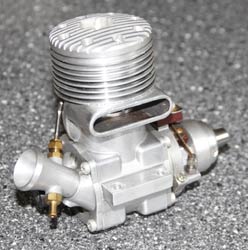 |
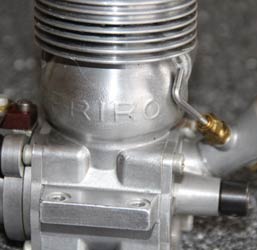 |
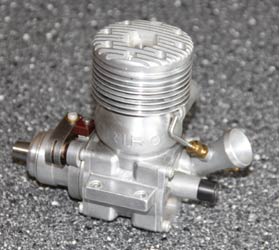 |
| Sold as a reproduction but is it a Rolli repro or from another source? Now confirmed as an original from 1965/8 | ||
|
Miquel also had an original AMRO with a magneto, and although we know where the supposed repro ended up, of the originals there is no further information. Like all other motors at the times, values shot up dramatically, with Doolings going from a tenner a time to around £500, and even more with a magneto. A British speed flyer sold two AMROs for a tenner each, but to whom is impossible to establish, but the rarity of the Swiss motors ensured that their value soon exceeded that of a Dooling. |
|
|
This brings us right back to the start, as by a wonderful coincidence or stroke of foresight, the dies and production tools of the FRIRO survive to the present day, as do those for the Oliver. Whilst the Oliver equipment has changed hands twice to allow production of these iconic diesels to continue, all the similar equipment relating to the Swiss motors, as well as some spare parts, had been retained by Fritz Rolli and his son at the FRIRO company. It was still a great surprise though to hear that the company was going to produce a final batch of six motors. OTW was privileged to be made aware of this venture along with the progress of the motors through their building and testing. Of the six, three carried the FRIRO name, two AMRO and one left plain and retained by Fritz Rolli.
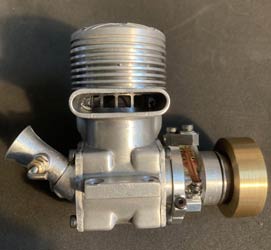 |
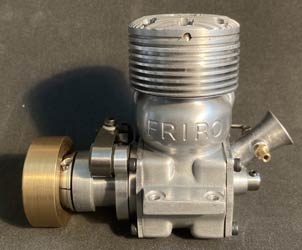 |
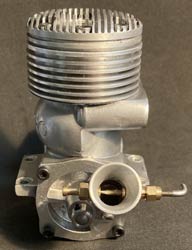 |
| One of the latest batch of five motors produced by Rolli Ag. Note the superb quality of the castings | ||
From information we have received, it seems likely that there are probably only around 20 to 30 original FRIRO motors and prototypes? Although there were more AMROs, we will never know the precise numbers of motors produced as Fritz Rolli Jnr recently confirmed that the engines never had serial numbers. Below are examples of each motor that were offered for sale some while ago. Even close examination of available photos makes it impossible to establish if these are originals or excellent copies. It is hoped that a forensic examination against a known original will establish their bonafide?
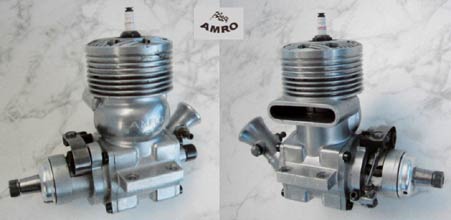 |
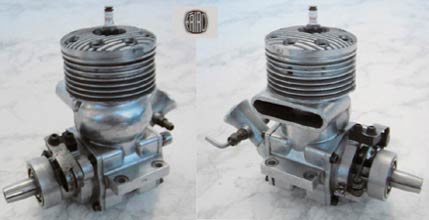 |
| Immaculate AMRO | FRIRO that carries a serial number |
It is strange and unusual that we have never seen either version in the flesh, having to rely until recently on small images printed in magazines and books. Happily, a number of images of the engines have been forthcoming since our interest in them became known. We have, however, been appraised of one star item, a complete tethered car, still with its original AMRO motor that was built and run around 1958/59 by Hans Wegmuller, who started as an apprentice at Rolli Ag, moving on to become a mechanic there before starting his own company in Bern.
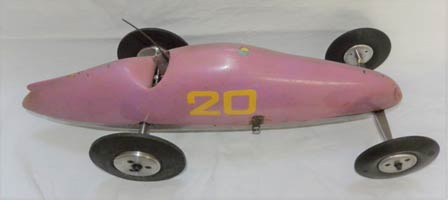 |
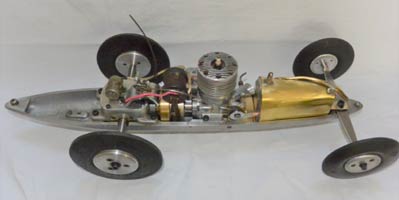 |
| Hans Wegmuller's AMRO engined tethered car from the late 1950s, now sympathetically restored | |
Any article such as this is entirely dependent on the initial impetus that sets the process underway, and then the information that can be discovered or is received along the way. Our thanks go to Christoph Zaugg for providing the catalyst that started the whole process, along with important information, engine photos and original material from the Rolli family, John Goodall for original photos, and Stuart Robinson for his recollections. The very poor photos of the first AMRO we became aware of were printouts from the late Miquel de Rancougne. It was our hope when we received these photos from Miquel over twenty years ago that one day we might actually see an original AMRO, still waiting though?
Update May/Sept 2023: Sadly, less than a month after publishing this article Fritz Rolli died. He had planned to produce another six engines but now it is unclear whether the company will carry on with this venture or not. The situation regarding all the archive material and production equipment is also currently unknown.
However, on our spring tour, we were privileged to be able to examine and handle a number of original engines in two locations, which included two AMROs and four FRIROs. The motor on the extreme right in the photo below is the unique twin plug FRIRO that Freddy Streun used to win the European Championship in Turin and set a world record. Thanks to one of our supporters for bringing these motors to Kapfenhardt, yet the surprises did not stop there. At Witterswill in August, Werner Metzger dug into his rucksack and amongst other motors produced another AMRO that had also belonged to Freddy Streun, this time a single plug version, so we know that there are at least seven of these Swiss motors still in existence.
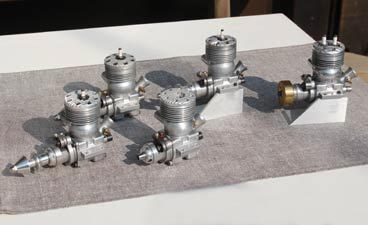 |
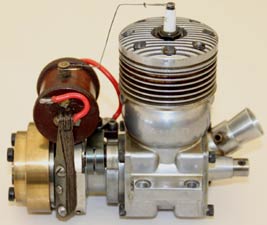 |
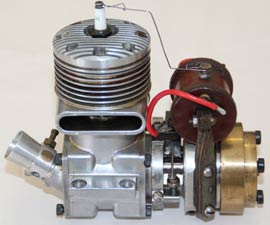 |
| Four FRIROs, AMRO 2nd right | Freddy Streun's AMRO | |
|
Update April 2025: Coincidental to the discovery of two of Jim Dean's cars was a chance find by one of our correspondents of an original AMRO 61, a bit distressed and minus a few bits, but nonetheless a rare discovery. The flywheel shows it to have been running on either a coil and battery and later, as the timer is missing, with glow plug ignition rather than magneto. The four pin coupling is very similar to the system used on the original motors in Switzerland, which mostly used the Ian Moore style gearbox. Right: original AMRO 61 |
|
Update June 2025: The AMRO pictured above has now been tidied up, and thanks to a reader living near to the Rolli factory, a replacement cylinder head sourced for fitting in due course. (What are the chances of that sixty five years on?) That was not all though, as lurking in the display cabinet along with it was the AMRO successor, a FRIRO. This is believed to have been put together at the factory from existing parts in the 1960s rather than coming from the later short production run?
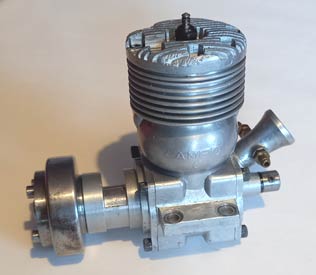 |
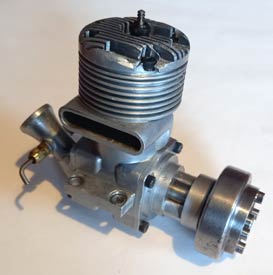 |
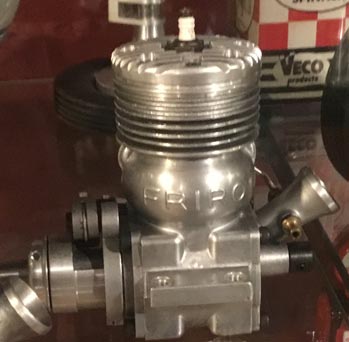 |
|
Now cleaned, freed up and with a replacement venturi, a handsome motor |
Pristine FRIRO | |
| Update Aug 2025: What had not been appreciated when the previous update was published was that the head from the factory was a raw casting but that there were also two fully machined heads that were spares from the pitbox of the late Kurt Zahnd. Kurt was European Champion in 1958, setting a new record in the process. What is unclear after all this time was why there was such a strange fin pattern on one of the spares? If finding a spare head after all this time was not amazing enough, it was even more of a surprise when both spares fitted precisely, even down to the eight head studs. The surprises did not end there as all the Allen screws are similar to those used on the OPS motors in that the heads have imperial hex sockets. The next stage is to source a suitable pan. |
|
Swiss Twins: Since the last update it has been possible to unite both an AMRO and FRIRO for a photo opportunity as well as sourcing the missing timer for the AMRO, except that did not go quite as planned. After a long search, the correct timer was located, so just a matter of fitting. That is where the fun started as first of all, the flywheel was found to have a reverse collett unlike anything seen previously and caused a bit of head scratching. The timer fitted perfectly, but resolutely failed to open and close the points. Ah, simple cause, the crankshaft is plain with no cam, so in spite of the front housing intended for a contact breaker, the motor seems to have been built and run as a glow version. More information added to the archive and a timely reminder to check first as all might not be as it appears?
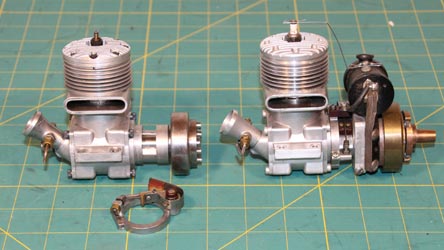 |
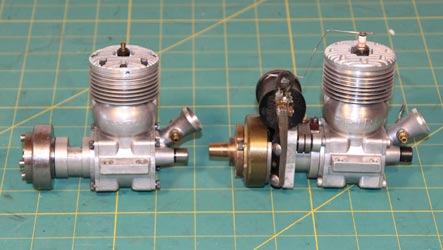 |
| Glow ign AMRO with new head and redundant timer | FRIRO complete with magneto |
©copyrightOTW2025